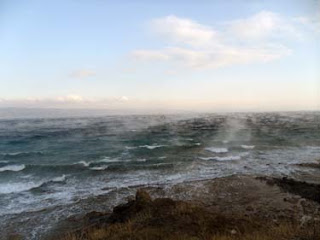(Marlboro sea)
Real winter conquered the island some weeks ago. Mt Lepetimnos got sugared with snow for the third or fourth time, Agiasos was covered under a pretty thick layer of snow, as was Megalochori and other places in the Middle and West of the island and on an early morning the snow even visited Eftalou, a place not really known for such a white blanket. Now there’s a Siberian gale blowing over the island and I have heard somebody say that the wind chill is -10 °C, although the mercury only sits at 0 °C.
This morning I woke up to see that the sea was smoking. The first winter I spent on Lesvos and seeing this phenomenon – the ice-cold air above a still warm sea produces smoke above the water – I called it a ‘Marlboro Sea’. Because I didn’t speak Greek well enough to explain to my Greek neighbours that the sea was steaming, I told them that the sea smoked Marlboro cigarettes.
Whilst the sea lights another cigarette and I bundle myself up as if travelling to the North Pole (I still have to walk my dogs) the spring has opened up another offensive. And this is what I like so much about Greek winters: it is never only winter, it also is a little bit spring.
During the winter period the months were pretty dry and even now not enough rain has fallen to encourage the thirsty plants hiding under the ground to lift themselves out of the earth. Other years there were plenty of anemones around by now, but this winter there have been very few. Until last week, when serious rain wet the landscape and they came with abundance—the quite happy anemones, showing their pretty colours in the winter land.
Because of the drought there were only a few wild mushrooms in autumn and even the meadow mushrooms, which are not usually winter shy, barely appeared. Only after the rain of last week, did they spring out of the ground and I was able to pick a basketful.
The almond blossoms also don’t care for the cold. Some of them, quite courageous in view of the ice cold wind, have already opened their delicate pink petals. I do hope the tiny flower buds that they hide are frost resistant because the weather forecast predicts that in the coming days temperatures will go a lot below zero.
The icy winter landscape is perked up with the brightly coloured oranges, mandarins and lemons hanging in the trees, ready to be harvested. They will provide lots of vitamins C, a good protection for this long cold snap.
And then there’s the horta, the wild vegetables, that grow in abundance. Like the young nettles that are wonderful in an omelet. Last week I picked a horta, even more prickly than the nettles: the young leaves of the milk thistle.
Milk thistles are very healthy to eat: they are good against liver and gallbladder disease and they even seem to protect your liver when you consume too much booze.
The story goes that the white spots on their leaves are thanks to the Virgin Maria, who on her get-away from the Romans to protect baby Jesus, spilt her mother milk on the leaves of thistles.
Milk thistles in the summer can grow as high as two metres. Their leaves are pretty prickly; even their starting rosettes, from where their purple flowers (butterflies love them) will grow are already pretty prickly. It was no easy job to collect these milk thistles. But somehow you just learn how to collect them; although washing them was another dangerous job. As their rosettes lay nearly flat to the ground while you cut them there will always be some earth with it and they do need a good washing before you throw them in their hot bath to be cooked. Put on some gloves! On the internet I read a recipe that stated that you had to cut all prickles from the leaves. I think that would be a lot of work because those small rosettes have lots of leaves and those leaves have even more prickles. I certainly didn’t intend to cut all those prickles; collecting and washing them had already been a long enough job. I suspect that the writer of that recipe had never actually cooked thistles, because when the leaves are boiled, their prickles become soft and tender and glide smoothly down your throat.
So after the prickling preparations and the boiling, I removed the stems from some big champignons (the meadow mushrooms were too small to be filled), chopped the stems and fried them with diced onions and bacon. I fried the champignon caps until they shrank and removed them from the pan. I finely cut the thistles leaves, added them to the mushroom-bacon mix and seasoned it with some salt, pepper and thyme. With this mixture I filled the mushrooms: champignons filled with milk thistle! It is a nice side dish or a fine meze to go with a glass of ouzo and very good for people intending to hit the bottle.
So you see that a Greek winter does not offer only cold.











